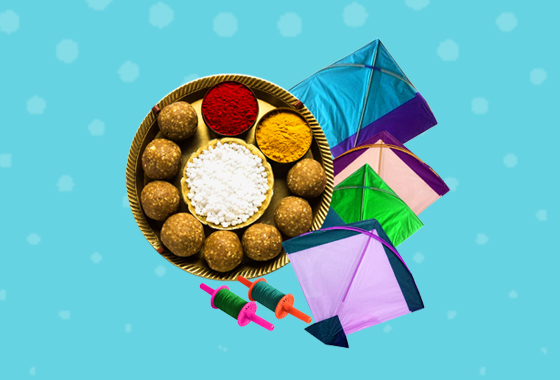Diverse cultures and traditions together make our India. Every corner of our country is home to different festivals and joy.
One such among them is Makar Sankranti, the harvest festival of India.
The festival marks the northward movement of the sun and that is why it is called Uttrayan in Gujarat.
A solar festival, Sankranti usually falls on 13th, 14th or 15th of every month when the planet Sun enters the Capricorn Zodiac sign which is called Makar Rashi in Hindi.
The Makar Sankranti occurs in the Lunar month of Magha according to the Hindus and in the January according to the solar calendar.
It also indicates the end of the winter solstice. Apart from its spiritual and astrological significance, the festival is also known as the Kite festival.
The festival is also known as the harvest festival in India. It shares a bond with farmers, foods, and grains.
The month of January commemorates the commencement of the Rabi Corps.
History
Ample mythological stories and religious significance are associated with the sacred Makar Sankranti.
According to one mythology, it is believed that the Sun (Surya Dev) pays a visit to his son Saturn (Shani Dev) who is the lord of the Capricon zodiac sign (Makar Rashi).
Hence, the festival symbolizes the mutual bond between father and son and unfathomable love of a father towards his son.
One of the sacred stories says that the Lord Vishnu triumphed over the demons on the day of Makar Sankranti.
Lord Vishnu beheaded the demons and buried under the Mandara Parvat to convey the victory of justice over injustice.
As per another Hindu mythology, Sankranti was a goddess who killed a devil named Sankarasur.
The next day to Makar Sankranti, called Karidin or Kinkrant, is the day when goddess Sankranti slew Sankarasur. On Makar Sankranti, the sun starts its Uttrayan journey, i.e. going towards the Northward movement.
Important Facts
- Makar Sankranti is followed by a very ancient Hindu tradition; taking a holy bath in one of the sacred rivers in Varanasi, Haridwar, Ujjain, Nashik, and Allahabad.
- The sun is worshipped with a haldi-kumkum ceremony followed by a sacred puja.
- Traditional eateries include til or sesame seeds laddoo.
Also Read: The world of Optical Illusion
Kite Festival
Today, Kite flying has become a marked part of Makar Sankranti.
Colorful kites adorn the beautiful sky of Gujarat during the celebration of International Kite Festival at Ahmedabad, Gujarat.
The city has been hosting International Kite Festival since 1989.
Different Regions, Different Names
- Haryana and Punjab– Lohri – At night, people gather around the bonfire and throw til, puffed rice and corns into the flames of the bonfire as prayers to seeking abundance and prosperity.
- Bihar– Khichdi- On this day, it is tagged auspicious to donate urad, rice, gold, woollen clothes, blankets, etc.
- Maharashtra– All married women donate cotton, oil, and salt to other married women on their first Sankrant.
- Bengal– The festival is followed by an old tradition of donating til after taking bath on Makar Sankrant. At Gangasagar, a colossal fair is organized on this auspicious day.
- Tamil Nadu– On the occasion of Makar Sankranti, the festival is celebrated as Pongal for four days.
- The festival is also called Sukarat in Central India and Magh Bihu in Assam.
- Andhra Pradesh, Telengana and Kerala – Makar Sankranthi
- Karnataka – Makar Sankramana, Makar Sankranthi, Suggi Habba
- Odisha, Bihar, West Bengal, Jharkhand, Jammu, Goa, Chhatishgarh, Maharashtra, Manipur, Madhya Pradesh, Sikkim, Rajasthan, Tripura, Uttarakhand and Uttar Pradesh – Makar Sankranti
- Tamil Nadu – Thai Pongal, Uzhavar, Thirunal
- Gujarat – Uttarayan
- Himachal Pradesh – Maghi
- Andhra Pradesh and Telangana – The festival Makar Sankranti is celebrated for 4 days in Andhra Pradesh and Telangana. This celebrated as Day 1 – Bhogi, Day 2 – Makar Sankranti the principal festival of the day, Day 3 – Kanuma, Day 4 – Mukknuma
- The first day of festival is called Bhogi in Andhra Pradesh and Telangana that takes place just before Makar Sankranti
- Similarly, the Makar Sankranti is known as Maghe Sankranti in Nepal, Shakrain/Poush Sangkranti in Bangladesh and Tirmoori in Pakistan (Sindh)
Celebration of Makara Sankranti across different states
- Makar Mela in Odisha
- Kumbh Mela in Uttar Pradesh
- Gangasagar Mela and Poush Mela (at Shantiniketan) in West Bengal
Further Reading:




